Cell-cell communications shape tumor microenvironment and predict clinical outcomes in clear cell renal carcinoma
- PMID: 36765369
- PMCID: PMC9921120
- DOI: 10.1186/s12967-022-03858-x
Cell-cell communications shape tumor microenvironment and predict clinical outcomes in clear cell renal carcinoma
Abstract
Background: Cell-cell communications of various cell populations within tumor microenvironment play an essential role in primary tumor growth, metastasis evolution, and immune escape. Nevertheless, comprehensive investigation of cell-cell communications in the ccRCC (Clear cell renal carcinoma) microenvironment and how this interplay affects prognosis still remains limited.
Methods: Intercellular communications were characterized by single-cell data. Firstly, we employed "CellChat" package to characterize intercellular communications across all types of cells in microenvironment in VHL mutated and non-mutated samples from 8 patients, respectively. And pseudotime trajectory analyses were performed with monocle analyses. Finally clinical prognosis and immunotherapy efficacy with different landscapes of intercellular interplay are evaluated by TCGA-KIRC and immunotherapy cohort.
Results: Firstly, the VHL phenotype may be related to the intercellular communication landscape. And trajectory analysis reveals the potential relationship of cell-cell communication molecules with T cells and Myeloid cells differentiation. Furthermore, those molecules also correlate with the infiltration of T cells and Myeloid cells. A tumor cluster with highly expressed ligands was defined by quantitative analysis and transcription factor enrichment analysis, which was identified to be pivotal for intercellular communications in tumor microenvironment. Finally, bulk data indicates bulk that different clusters with different intercellular communications have significant predictive value for prognosis and distinguished immunotherapy efficiency.
Conclusions: The intercellular communication landscapes of VHL wild and VHL mutant ccRCC vary. Intercellular communications within the tumor microenvironment also influence T cell and myeloid cell development and infiltration, as well as predict clinical prognosis and immunotherapy efficacy in ccRCC.
Keywords: Cell–cell communications; Clear cell renal carcinoma; Immunotherapy; Prognosis; Tumor microenvironment.
© 2023. The Author(s).
Conflict of interest statement
The authors declare that they have no competing interests.
Figures
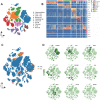

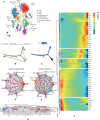
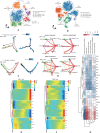
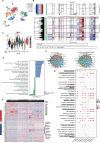
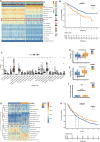
Similar articles
-
Single-cell disulfidptosis regulator patterns guide intercellular communication of tumor microenvironment that contribute to kidney renal clear cell carcinoma progression and immunotherapy.Front Immunol. 2024 Jan 16;15:1288240. doi: 10.3389/fimmu.2024.1288240. eCollection 2024. Front Immunol. 2024. PMID: 38292868 Free PMC article.
-
Single-cell transcriptomic analyses provide insights into the tumor microenvironment heterogeneity and invasion phenotype in retinoblastoma.Pathol Res Pract. 2025 Jul;271:156009. doi: 10.1016/j.prp.2025.156009. Epub 2025 May 12. Pathol Res Pract. 2025. PMID: 40378583
-
Development of a polyamine gene expression score for predicting prognosis and treatment response in clear cell renal cell carcinoma.Front Immunol. 2022 Nov 25;13:1048204. doi: 10.3389/fimmu.2022.1048204. eCollection 2022. Front Immunol. 2022. PMID: 36505496 Free PMC article.
-
The utilization of single-cell sequencing technology in investigating the immune microenvironment of ccRCC.Front Immunol. 2023 Nov 27;14:1276658. doi: 10.3389/fimmu.2023.1276658. eCollection 2023. Front Immunol. 2023. PMID: 38090562 Free PMC article. Review.
-
The cell stress and immunity cycle in cancer: Toward next generation of cancer immunotherapy.Immunol Rev. 2024 Jan;321(1):71-93. doi: 10.1111/imr.13287. Epub 2023 Nov 8. Immunol Rev. 2024. PMID: 37937803 Review.
Cited by
-
Integrated single-cell and bulk RNA-sequencing data reveal molecular subtypes based on lactylation-related genes and prognosis and therapeutic response in glioma.Heliyon. 2024 May 6;10(9):e30726. doi: 10.1016/j.heliyon.2024.e30726. eCollection 2024 May 15. Heliyon. 2024. PMID: 38765164 Free PMC article.
-
PDT-regulated immune gene prognostic model reveals tumor microenvironment in colorectal cancer liver metastases.Sci Rep. 2025 Apr 16;15(1):13129. doi: 10.1038/s41598-025-97667-z. Sci Rep. 2025. PMID: 40240471 Free PMC article.
-
Radiomics predicts the prognosis of patients with clear cell renal cell carcinoma by reflecting the tumor heterogeneity and microenvironment.Cancer Imaging. 2024 Sep 16;24(1):124. doi: 10.1186/s40644-024-00768-7. Cancer Imaging. 2024. PMID: 39285496 Free PMC article.
-
Screening of differential gene expression patterns through survival analysis for diagnosis, prognosis and therapies of clear cell renal cell carcinoma.PLoS One. 2024 Sep 30;19(9):e0310843. doi: 10.1371/journal.pone.0310843. eCollection 2024. PLoS One. 2024. PMID: 39348357 Free PMC article.
-
The diversification of methods for studying cell-cell interactions and communication.Nat Rev Genet. 2024 Jun;25(6):381-400. doi: 10.1038/s41576-023-00685-8. Epub 2024 Jan 18. Nat Rev Genet. 2024. PMID: 38238518 Free PMC article. Review.
References
-
- Nickerson ML, Jaeger E, Shi Y, Durocher JA, Mahurkar S, Zaridze D, Matveev V, Janout V, Kollarova H, Bencko V, Navratilova M, Szeszenia-Dabrowska N, Mates D, Mukeria A, Holcatova I, Schmidt LS, Toro JR, Karami S, Hung R, Gerard GF, Linehan WM, Merino M, Zbar B, Boffetta P, Brennan P, Rothman N, Chow W-H, Waldman FM, Moore LE. Improved identification of von Hippel-Lindau gene alterations in clear cell renal tumors. Clin Cancer Res. 2008;14:4726–4734. doi: 10.1158/1078-0432.CCR-07-4921. - DOI - PMC - PubMed
-
- Yang D, Jones MG, Naranjo S, Rideout WM, 3rd, Min KHJ, Ho R, Wu W, Replogle JM, Page JL, Quinn JJ, Horns F, Qiu X, Chen MZ, Freed-Pastor WA, McGinnis CS, Patterson DM, Gartner ZJ, Chow ED, Bivona TG, Chan MM, Yosef N, Jacks T, Weissman JS. Lineage tracing reveals the phylodynamics, plasticity, and paths of tumor evolution. Cell. 2022;23:67. - PMC - PubMed
MeSH terms
LinkOut - more resources
Full Text Sources
Medical

